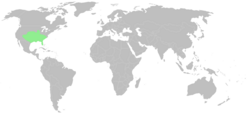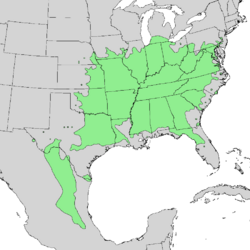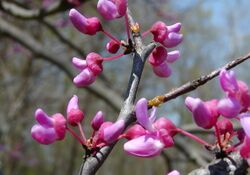Biology:Cercis canadensis
| Cercis canadensis | |
|---|---|

| |
| Eastern redbud near Cincinnati, Ohio | |
| Scientific classification | |
| Kingdom: | Plantae |
| Clade: | Tracheophytes |
| Clade: | Angiosperms |
| Clade: | Eudicots |
| Clade: | Rosids |
| Order: | Fabales |
| Family: | Fabaceae |
| Genus: | Cercis |
| Species: | C. canadensis
|
| Binomial name | |
| Cercis canadensis L. (1753)
| |
| Subspecies[2] | |
| |

| |

| |
| Natural range of the eastern redbud | |
| Synonyms[2] | |
| |
Cercis canadensis, the eastern redbud, is a large deciduous shrub or small tree, native to eastern North America from southern Michigan south to central Mexico, west to New Mexico. Species thrive as far west as California and as far north as southern Ontario.[3] It is the state tree of Oklahoma. The prevalence of the so-called "Columbus strain" has seen the residents of Columbus, Wisconsin embrace the plant into their city's identity.[4] Known as the "Redbud City," the town hosts "Redbud Day" annually the Saturday before Mother's Day, organizing a variety of themed events to recognize the tree.[5]
Description
The eastern redbud typically grows to 6–9 m (20–30 ft) tall with an 8–10 m (26–33 ft) spread. It generally has a short, often twisted trunk and spreading branches. A 10-year-old tree will generally be around 5 m (16 ft) tall. The bark is dark in color, smooth, later scaly with ridges somewhat apparent, sometimes with maroon patches. The twigs are slender and zigzag, nearly black in color, spotted with lighter lenticels. The winter buds are tiny, rounded and dark red to chestnut in color. The leaves are alternate, simple, and heart shaped with an entire margin, 7–12 cm (3–4.5 in) long and wide, thin and papery, and may be slightly hairy below.
The flowers are showy, light to dark magenta pink in color, 1.5 cm (1⁄2 in) long, appearing in clusters from spring to early summer, on bare stems before the leaves, sometimes on the trunk itself. There are cultivars with white flowers. The flowers are pollinated by long-tongued bees such as blueberry bees and carpenter bees. Short-tongued bees cannot reach the nectaries. The fruit are flattened, dry, brown, pea-like pods, 5–10 cm (2–4 in) long that contain flat, elliptical, brown seeds 6 mm (1⁄4 in) long, maturing in August to October.

- Bark: Red brown, with deep fissures and scaly surface. Branchlets at first lustrous brown, later become darker.
- Wood: Dark reddish brown; heavy, hard, coarse-grained, not strong. Sp. gr., 0.6363; weight of cu. ft. 39.65 lbs.
- Winter buds: Chestnut brown, obtuse, one-eighth inch long.
- Cotyledons oval, flat
- Leaves: Alternate, simple, heart-shaped or broadly ovate, two to five inches long, five to seven-nerved, cordate or truncate at the base, entire, acute. They come out of the bud folded along the line of the midrib, tawny green; when they are full grown they become smooth, dark green above, paler beneath. In autumn they turn bright clear yellow. Petioles slender, terete, enlarged at the base. Stipules caducous.
- Flowers: April, May, before and with the leaves, papilionaceous. Perfect, rose color, borne four to eight together, in fascicles which appear at the axils of the leaves or along the branch and sometimes on the trunk itself.
- Calyx: Dark red, campanulate, oblique, five-toothed, imbricate in bud.
- Corolla: Papilionaceous, petals five, nearly equal, pink or rose color, upper petal the smallest, enclosed in the bud by the wings, and encircled by the broader keel petals.
- Stamens: Ten, inserted in two rows on a thin disk, free, the inner row rather shorter than the others.
- Pistil: Ovary superior, inserted obliquely in the bottom of the calyx tube, stipitate; style fleshy, incurved, tipped with an obtuse stigma.
- Fruit: Legume, slightly stipitate, unequally oblong, acute at each end. Compressed, tipped with the remnants of the style, straight on upper and curved on the lower edge. Two and a half to three inches long, rose color, full grown by midsummer, falls in early winter. Seeds ten to twelve, chestnut brown, one-fourth of an inch long.
Subspecies
Three subspecies are accepted:[2]
- Cercis canadensis subsp. canadensis (synonyms C. dilatata, C. ellipsoidea, and C. georgiana) – eastern and Central United States to northeastern and central Mexico[6]
- Cercis canadensis subsp. mexicana (Rose) A.E.Murray (synonym C. mexicana) – northeastern Mexico, southwestern Texas (Trans-Pecos), southeastern New Mexico[7]
- Cercis canadensis subsp. texensis (S.Watson) A.E.Murray (synonyms C nitida, C. reniformis, and C. texensis) Oklahoma redbud – Oklahoma and Texas east of the Pecos River[8]
Ecological benefits
The leaves are eaten by the caterpillars of some Lepidoptera—for example, Henry's elfin, the redbud leaffolder, the red-humped caterpillar (which can cause extensive defoliation in late summer but generally does no lasting harm to a healthy tree),[9] the fall webworm (also a late-season defoliator),[3] the white flannel moth, the American dagger moth, the grape leaffolder, and the Io moth.
Cultivation
Cercis canadensis is grown in parks and gardens, with several cultivars being available. The cultivars 'Forest Pansy'[10] and 'Ruby Falls'[11] have gained the Royal Horticultural Society's Award of Garden Merit (confirmed 2017).[12] Both are cultivated for their showy purple leaves, which turn brilliant shades of red and orange in the fall (autumn). 'Ruby Falls' is a weeping form.
In the wild, eastern redbud is a frequent native understory tree in mixed forests and hedgerows. It is also much planted as a landscape ornamental plant.
In the United States, this tree is difficult to grow farther west into arid areas west of western Kansas and Colorado, as there is not enough rain. There has been success growing the tree in Columbus, Wisconsin, whose cultivar has become known as the "Columbus strain" and is a seed source for nurseries. Seeds can be made to germinate by first dipping in boiled (99 °C) water for one minute and then sowing in a pot (do not boil the seeds).[13]
Cercis canadensis var. mexicana are tolerant of high salinity levels allowing them to grow more effectively in areas similar to the southwestern United States.[14]
Uses
The flowers can be eaten fresh or fried.[15]
In some parts of southern Appalachia, green twigs from the eastern redbud are used as seasoning for wild game such as venison and opossum. Because of this, in these mountain areas the eastern redbud is sometimes known as the spicewood tree.[citation needed]
Native Americans consumed redbud flowers raw or boiled, and ate roasted seeds. Analysis of nutritional components in edible parts of eastern redbud reported that the flower extract contains anthocyanins, green developing seeds contained proanthocyanidin, and linolenic, α-linolenic, oleic and palmitic acids are present in seeds.[16]
References
- ↑ IUCN SSC Global Tree Specialist Group.; Botanic Gardens Conservation International (2020). "Cercis canadensis". IUCN Red List of Threatened Species 2020: e.T33892A155693644. doi:10.2305/IUCN.UK.2020-1.RLTS.T33892A155693644.en. https://www.iucnredlist.org/species/33892/155693644. Retrieved 19 November 2021.
- ↑ 2.0 2.1 2.2 Cercis canadensis L. Plants of the World Online. Retrieved 15 August 2023.
- ↑ 3.0 3.1 Gilman, Edward F.; Watson, Dennis G. (November 1993). "Cercis canadensis 'Flame': 'Flame' Eastern Redbud". Environmental Horticulture Department, Florida Cooperative Extension Service, Institute of Food and Agricultural Sciences, University of Florida. https://hort.ifas.ufl.edu/database/documents/pdf/tree_fact_sheets/cercanb.pdf.
- ↑ "The History of Columbus". Columbus Wisconsin Area Chamber of Commerce. https://www.columbuswichamber.com/history-of-columbus.
- ↑ "Redbud Days 2023 should be fun". Columbus Wisconsin Area Chamber of Commerce. https://columbuswischamber.news/redbud-days-2023-should-be-fun/.
- ↑ Cercis canadensis subsp. canadensis. Plants of the World Online. Retrieved 15 August 2023.
- ↑ Cercis canadensis subsp. mexicana Rose. Plants of the World Online. Retrieved 15 August 2023.
- ↑ Cercis canadensis subsp. texensis (S.Watson) A.E.Murray. Plants of the World Online. Retrieved 15 August 2023.
- ↑ "Problems With Forest Pansies" (in en). https://homeguides.sfgate.com/problems-forest-pansies-75201.html.
- ↑ "RHS Plant Selector Cercis canadensis 'Forest Pansy'". Apps.rhs.org.uk. https://www.rhs.org.uk/Plants/95578/Cercis-canadensis-Forest-Pansy/Details.
- ↑ "RHS Plantfinder - Cercis canadensis 'Ruby Falls'". Royal Horticultural Society. https://www.rhs.org.uk/Plants/301699/i-Cercis-canadensis-i-Ruby-Falls-sup-(PBR)-sup/Details.
- ↑ "AGM Plants - Ornamental". Royal Horticultural Society. July 2017. p. 16. https://www.rhs.org.uk/plants/pdfs/agm-lists/agm-ornamentals.pdf.
- ↑ Keeler, Harriet L. (1900). Our Native Trees and How to Identify Them. New York: Charles Scribner's Sons. pp. 104–108. https://archive.org/details/ournativetreesa02keelgoog.
- ↑ Niu, Genhua; Rodriguez, Denise S.; Gu, Mengmeng (2010-03-01). "Salinity Tolerance of Sophora secundiflora and Cercis canadensis var. mexicana" (in en-US). HortScience 45 (3): 424–427. doi:10.21273/HORTSCI.45.3.424. ISSN 0018-5345. https://journals.ashs.org/hortsci/view/journals/hortsci/45/3/article-p424.xml.
- ↑ Little, Elbert L. (1994). The Audubon Society Field Guide to North American Trees: Western Region (Chanticleer Press ed.). Knopf. p. 491. ISBN 0394507614.
- ↑ "Laura J. Hunter, et al. 2006. Analysis of nutritional components in edible parts of eastern redbud (Cercis canadensis L.). 62nd Southwest Regional American Chemical Society Meeting, Houston, Texas.". http://acs.confex.com/acs/swrm06/techprogram/P37508.HTM.
External links
- Cercis canadensis Large format diagnostic photographs and information.
- Morton Arboretum tree general description and a list of cultivars
- Cercis canadensis images at bioimages.vanderbilt.edu
- NCRS: USDA Plants Profile: Cercis canadensis
Wikidata ☰ Q2452407 entry
 |






